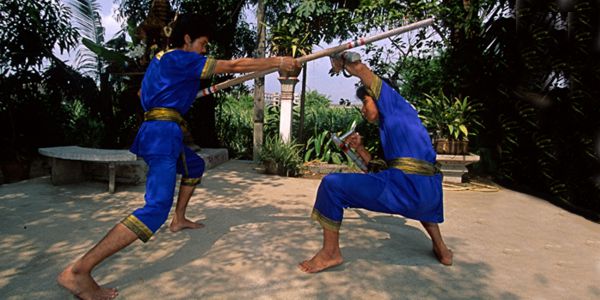Krabi-Krabong is the art of sword and staff fighting in Thailand. This weapons system is hundreds of years old. Its weapons are made of wood such as rattan. In contests, opponents attack and defend in turn, like prearranged or step sparring, but contact is frequently made. The art combines Chinese, Japanese and Indian martial arts techniques with indigenous Thai methods. (From The Martial Arts Encyclopedia by Jennifer Lawler)
This traditional Thai martial art is still practiced in Thailand. This tradition focuses on hand-held weapons as well as empty hand techniques. Specifically the:
“Krabi” (sword)
“Plong” (quarterstaff)
“Ngao” (staff with blade in the end)
“Daab Song Meu” (a pair of swords held in each hand)
“Mae Sun-Sawk” (a pair of clubs)
Although for most Thais Krabi-Krabong is a ritual to be display during festivals or at tourist venues, the art is still solemnly taught according to a 400-years-old tradition handed down from Ayutthaya’s Wat PutthaiSwan. The King’s elite bodyguard are trained in Krabi-Krabong; many Thai cultural observers perceive it as a “purer” tradition.
Like Muay Thai of 70 years ago, modern Krabi-Krabong matches are held within a marked circle, beginning with a “Wai Kruu” ceremony and accompanied throughout by a musical ensemble. Thai boxing techniques and judo-like throws are employed in conjunction with weapons techniques. Although sharpened weapons are used, the contestants refrain from striking their opponents – the winner is decided on the basis of stamina and the technical skill displayed. Although an injured fighter may surrender, injuries do not automatically stop a match.
A VISIT WITH THE LATE ARJAN SUMAI
THE LAST GRANDMASTER OF KRABI KRABONG (1914 – 1998)
by Terry Tippie
KRABI-KRABONG – THE MOTHER OF MUAY THAI
by Mark Van Schuyver
for Black Belt Magazine


